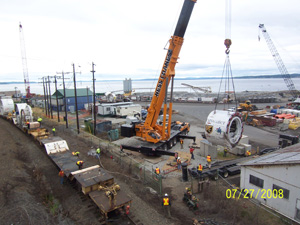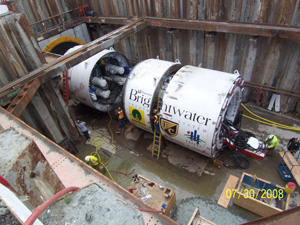Brightwater plan and rescue strategy
May 2010
Shani Wallis, TunnelTalk
- Fortunate, is how project manager for the client Gunars Sreibers described the situation on the Brightwater project in King County north of Seattle. “Fortunate,” he said, “in that we had a contractor and a tunnelling machine in a position to carry on and finish the suspended drive.”
-

The stranded TBM stands half way through its drive from North Kenmore to the Ballinger Way shaft
- The contractor referred to is the Jay Dee/Coluccio JV on the West Tunnel contract of the 13-mile (27km) long conveyance tunnel project, the TBM is the Lovat EPBM, and the suspended drive is the westbound heading of the Central Tunnel contract in which the slurry TBM lies stranded about half way between the North Kenmore working shaft and the Bellinger Way reception shaft (Fig 1). The recovery plan is to have the West Tunnel contractor continue its EPBM through the Bellinger Way shaft to complete the last 10,000ft of the troubled Central Tunnel drive and junction with the stranded slurry TBM.
- The alternative strategy was adopted by King County in February after enacting emergency powers to negotiate an extension contract with the West Tunnel Contractor and forego competitive tender of the work. The $68.9 million contact negotiated with Jay Dee/Coluccio (JC) is less than the additional $98 million estimated by the Central Tunnel contractor, the Vinci/Parsons RCI/Frontier-Kemper (VPFK) JV, to repair its damaged slurry TBM and complete the drive. The recovery plan is also anticipated to take substantially less time.
- Trouble for the Central Tunnel contract started about a year ago when the two Herrenknecht Mixshields working in opposite directions from the central North Kenmore shaft came to a standstill due to extensive wear damage to the rim and back side of the cutterheads. A comprehensive program of dewatering had the ground water table lowered sufficiently to allow repair of the eastbound BT2 drive TBM. But the combination of deep 330ft (100m) cover, under a high ground water table, and beneath a residential suburb proved too much for cost effective repair of the BT3 westbound machine. A rescue shaft in the residential area and through the deep over burden was not feasible and the high compressed air working pressures needed to withstand up to 7 bar water pressures allowed only short periods of man-entry intervention with long periods of decompression. There was also a lack of confidence that, after repair, the TBM would be able to carry on in the complex abrasive glacial conditions and complete the remaining half of the drive with success. Alternative strategies had to be considered.
- With the Jay Dee/Coluccio/Taisei (JCT) JV TBM closing in on the common Bellinger Way reception shaft after completing its eastward drive for the West Tunnel contract, the obvious solution presented itself.
- Under the new agreement, the original $102.5 million West Tunnel contract with JCT is closed out, explained Sreibers, and has been replaced with a cost reimbursable, fixed fee with incentives contract, to excavate the stalled Central Tunnel drive and complete the finishing works on the West Tunnel contract. As part of the negotiations, original JV partner Taisei withdrew from the project, citing over commitment on other projects as the reason.
- Meanwhile, the Central Tunnel contractor, VPFK will complete the 11,600ft (3.5km) eastbound drive on its $211 million contract and will come back into the westbound drive once excavated to complete its finishing works.
-

North Kenmore working site of the Central Tunnel
- The eastbound BT2 Mixshield required more extensive repair than its BT3 westbound counterpart but it was able to resume tunnelling in mid-February this year and has been progressing well since, according to Sreibers. It is now more than 10,000ft into the 11,600ft drive and is about to underpass the I-405 highway (Fig 1). "The projection is it will hole out into the North Creek shaft in late June/early July of this year."
- The JC Lovat EPBM is yet to breakthrough into the Bellingham shaft. After completing its 21,100ft (6.4km) drive, the 4.7m machine is about 150ft from the shaft and has been waiting since early March for ground freezing at the eye to control the high ground water table and prepare for a successful hole through into the 205ft deep x 21ft i.d. (62.5m x 6.5m) shaft.
- "Ground freezing has also been established for the breakout eye into the continuation into the Central Tunnel drive," said Greg Hauser, Project Manager for JC. "The freeze for both eyes is on the same system, so when we break in through the west eye, the freeze will be suspended and we will have about a month to complete the TBM overhaul and have the machine buried again before the freeze on the east eye thaws. We will work 24 hours a day, 7 days a week to get the TBM prepared for this additional 10,000ft of tunnelling."
- The Lovat EPBM worked under a maximum 5 bar pressure on the West Tunnel contract and will need to face working pressures up to 7 bar on the final half of the Central Tunnel contract. Slurry or EPB excavation was the contractor's choice for the West Tunnel contract but slurry tunnelling was specified by the MWH/Jacobs Associates design JV for the Central Tunnel contract.
- "We are working with Lovat technicians to get the machine set up for the Central Tunnel conditions," said Hauser. "As well as a complete overhaul, there are four main items of refurbishment to carry out – a rebuild of the cutterhead with extra hard facing against aggressive wear; replacement of all the tailseal brushes; reinforcement of the bearing and articulation seals; and upgrade of the hydraulic pumps and greasing systems of the seals."
- "The EPB machine will drive into the same conditions as encountered by the slurry machine on the Central Tunnel drive," said Sreibers, "but we are aware of the challenges and are preparing for them. The EPB machine completed the West Tunnel under 5 bar pressures with minimal interventions and we are hoping for the same on the additional Central Tunnel drive."
- For its extra 10,000ft, the Lovat EPBM will continue to be serviced from the West Tunnel’s Point Wells access portal at the junction to the project’s long sea effluent outfall pipeline into Puget Sound. This will mak for a total journey of more than 6 miles (near 10km) for the supply and muck trains.
- Exactly how the two machines will junction is yet to be defined although ground freezing for the operation is being considered. Exactly how the two machines within their sacrificial shields will be recovered is also being discussed.
- Another unknown is whether there will be any legal action as a result of the client’s imposed change of strategy on the contracts. As Sreibers said: “The focus for the moment is on getting the excavation of the tunnels completed and the project finished. Once the West Tunnel TBM is in the shaft and after its overhaul with a fine toothcomb we expect it to be relaunched by September. Predicting progress after that as you know is difficult in these exacting geological conditions, but the expectation is for the EPB machine to meet the stranded slurry machine by Fall 2011.”
- The two tunnel contracts are part of King County's $1.8 billion Brightwater project that comprises a new treatment plant and the 13-mile (27km) water conveyance tunnel to the ocean outfall pipeline. Construction of the treatment plant remains on schedule to be finished and in operation by the Fall 2011 and the East Tunnel contract by the Kenny/Shea/ Traylor JV, is on track for substantial completion by July this year. Its 5.9m diameter Lovat EPBM brokethrough in November 2008 to complete the 14,000ft (4.3km) East Tunnel drive from the North Creek shaft in about 14 months.
- The delay to commission of the conveyance tunnel due to the Central Tunnel problems is estimated at more than a year. The final turnout cost for its construction and who will bear responsibility for that additional cost is yet to play out.
- Brightwater mobilization - TunnelTalk, Sept 2007
Brightwater update - TunnelTalk, Aug 2008
Sinkhole bothers Brightwater - TunnelTalk, Mar 2009
Brightwater TBMs in trouble - TunnelTalk, Jun 2009
Dewatering assists Brightwater TBM repairs - TunnelTalk, Oct 2009
Brightwater action to limit costly delays - TunnelTalk, Feb 2010
|
|
|
|
|
Add your comment
- Thank you for taking the time to share your thoughts and comments. You share in the wider tunnelling community, so please keep your comments smart and civil. Don't attack other readers personally, and keep your language professional.



